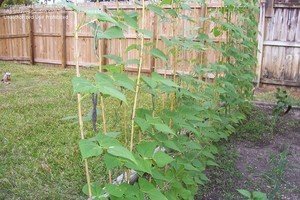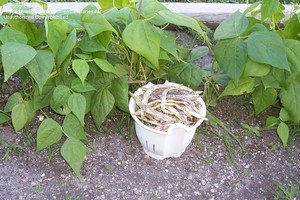





Pole beans or bush beans - which is right for your garden?
There are few garden crops more easy to grow, more rewarding for the effort than beans. For many home gardeners, the question is not whether to plant beans, but what kinds? This includes the question: pole beans or bush?The common bean (Phaseolus vulgaris) and its close relatives are native to Mesoamerica, where they have long been one of the staples of the diet. The original bean plant is a vine with a twining habit much like today's pole beans, suitable for growing in the "Three Sisters" method where the bean vines are planted to grow up the stalks of corn.
The bush bean is a much more recent development originally bred for ease of harvest. Today, almost all commercially-grown dry beans are bush varieties picked by mechanical harvesters at the end of the season; rather than picking the pods from the plant, the entire plant is harvested.
The development of bush versions of green snap beans came even later, but today many of the popular varieties of snap beans come in both pole and bush types. Gardeners only have to choose which ones they prefer.
The question is entirely one of preference. Neither type is better than the other in any absolute sense. There are, however, significant differences that gardeners should weigh before they make a decision.
Height: This is the most obvious difference. Pole beans can grow ten feet or more tall. Bush beans are less than two feet. Pole beans require some kind of trellis or pole teepee to climb. Bush beans are freestanding. It is usually claimed that bush bean plants do not require any support, but they are shallow-rooted, and I have sometimes found that heavily-bearing plants will tip over. The fruits are close to the ground and may become splashed with mud, and they are accessible to slugs and other pests. On the other hand, in a high wind, a trellis loaded with pole beans may be blown over. Constructing a stronger trellis may be more effort than some gardeners want to make.
Determinacy: Bush beans tend to be determinate; pole beans are indeterminate. This means that bush beans produce an entire crop all at once, while pole beans produce over the entire growing season. In both cases, keeping the beans picked will increase production. If the entire first crop is promptly picked while green, bush beans will produce a second crop and even keep bearing longer at a reduced rate, although the quality of the harvest deteriorates. Gardeners who want to harvest fresh green beans all season long may prefer the pole varieties, but making succession plantings of bush beans will produce similar results. Those who want to can or freeze a lot of beans may want to grow bush beans for a large harvest all at once.
over the entire growing season. In both cases, keeping the beans picked will increase production. If the entire first crop is promptly picked while green, bush beans will produce a second crop and even keep bearing longer at a reduced rate, although the quality of the harvest deteriorates. Gardeners who want to harvest fresh green beans all season long may prefer the pole varieties, but making succession plantings of bush beans will produce similar results. Those who want to can or freeze a lot of beans may want to grow bush beans for a large harvest all at once.
Harvesting: Bending down to pick green beans from low bush plants can definitely be hard on the back. Shorter gardeners, on the other hand, may require a ladder to reach the highest pole beans. For gardeners who want to pick green beans very young, they are easier to identify growing on bush plants; it can be hard to spot all the green fruits among the abundant foliage of the pole beans.
Yield: Pole beans are higher-yielding per square foot over the season. Letting a second crop develop on bush varieties will increase the yield.
Maturity: Most pole beans take longer to begin producing, often 70-80 days. Some varieties of bush beans can produce in as little as 45 days.
Size: In general, pole beans produce larger, longer pods than bush beans.
Selection: While many popular varieties have been developed as both pole and bush types, gardeners may prefer specific cultivars that are only available in one version. Heirloom beans tend to be available only as pole types. Dried beans are usually bush types, beans for growing as shellies more often pole types. In such cases, length of vine may be less important than other preferences
Heirloom beans tend to be available only as pole types. Dried beans are usually bush types, beans for growing as shellies more often pole types. In such cases, length of vine may be less important than other preferences
Quality: This is entirely a matter of personal taste, of course, but a large number of gardeners insist that pole beans have a better or more intense flavor than bush beans. The only way to tell is to grow them and see.
Which leads to a final consideration: if you can't make up your mind and you have the room in your garden, you can always grow both kinds.
Photo Credits: Thanks to Big_Red and Aries44
Copyright © www.100flowers.win Botanic Garden All Rights Reserved